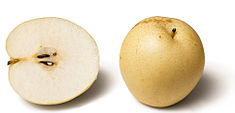Nashi Pear
| Pyrus pyrifolia | |
|---|---|
 |
|
| Scientific classification | |
| Kingdom: | Plantae |
| (unranked): | Angiosperms |
| (unranked): | Eudicots |
| (unranked): | Rosids |
| Order: | Rosales |
| Family: | Rosaceae |
| Genus: | Pyrus |
| Species: | P. pyrifolia |
| Binomial name | |
|
Pyrus pyrifolia (Burm.) Nak. |
|

Nashi pear (Pyrus pyrifolia)
|
|
| Nutritional value per 100 g (3.5 oz) | |
|---|---|
| Energy | 176 kJ (42 kcal) |
|
10.65 g
|
|
| Sugars | 7.05 g |
| Dietary fiber | 3.6 g |
|
0.23 g
|
|
|
0.5 g
|
|
| Vitamins | |
| Thiamine (B1) |
(1%)
0.009 mg |
| Riboflavin (B2) |
(1%)
0.01 mg |
| Niacin (B3) |
(1%)
0.219 mg |
| Pantothenic acid (B5) |
(1%)
0.07 mg |
| Vitamin B6 |
(2%)
0.022 mg |
| Folate (B9) |
(2%)
8 μg |
| Choline |
(1%)
5.1 mg |
| Vitamin C |
(5%)
3.8 mg |
| Vitamin E |
(1%)
0.12 mg |
| Vitamin K |
(4%)
4.5 μg |
| Minerals | |
| Calcium |
(0%)
4 mg |
| Magnesium |
(2%)
8 mg |
| Manganese |
(3%)
0.06 mg |
| Phosphorus |
(2%)
11 mg |
| Potassium |
(3%)
121 mg |
| Sodium |
(0%)
0 mg |
|
|
|
|
|
| Percentages are roughly approximated using US recommendations for adults. Source: USDA Nutrient Database |
|
Pyrus pyrifolia is a species of pear tree native to East Asia.
The tree's edible fruit is known by many names, including: Asian pear,Chinese pear,Korean pear, Japanese pear,Taiwanese pear, and sand pear. Along with cultivars of P. × bretschneideri and P. ussuriensis, the fruit is also called the nashi pear.Cultivars derived from Pyrus pyrifolia are grown throughout East Asia, and in other countries such as India, Australia, New Zealand, and the United States (e.g., California). Traditionally in East Asia the tree's flowers are a popular symbol of early spring, and it is a common sight in gardens and the countryside.
The fruits are not generally baked in pies or made into jams because they have a high water content and a crisp, grainy texture, very different from the European varieties. They are commonly served raw and peeled. The fruit tends to be quite large and fragrant, and when carefully wrapped (it has a tendency to bruise because of its juiciness), it can last for several weeks or more in a cold, dry place.
Due to their relatively high price and the large size of the fruit of cultivars, the pears tend to be served to guests, given as gifts, or eaten together in a family setting.
In cooking, ground pears are used in vinegar- or soy sauce-based sauces as a sweetener, instead of sugar. They are also used when marinating meat, especially beef.
In Korea, the fruit is known as bae (배), and it is grown and consumed in great quantity. In the South Korean city of Naju, there is a museum called The Naju Pear Museum and Pear Orchard for Tourists (나주 배 박물관 및 배밭 관광체험).
In Australia, these pears have been commercially produced for more than 25 years.
In Japan, fruit is harvested in Chiba, Ibaraki, Tottori, Fukushima, , Nagano, Niigata, Saitama and other prefectures, except Okinawa. Nashi (ja:梨) may be used as a late Autumn kigo, or “season word”, when writing haiku. Nashi no hana (ja:梨の花, pear flower) is also used as a kigo of spring. At least one city (Kamagaya-Shi, Chiba Prefecture) has the flowers of this tree as an official city flower.
...
Wikipedia
